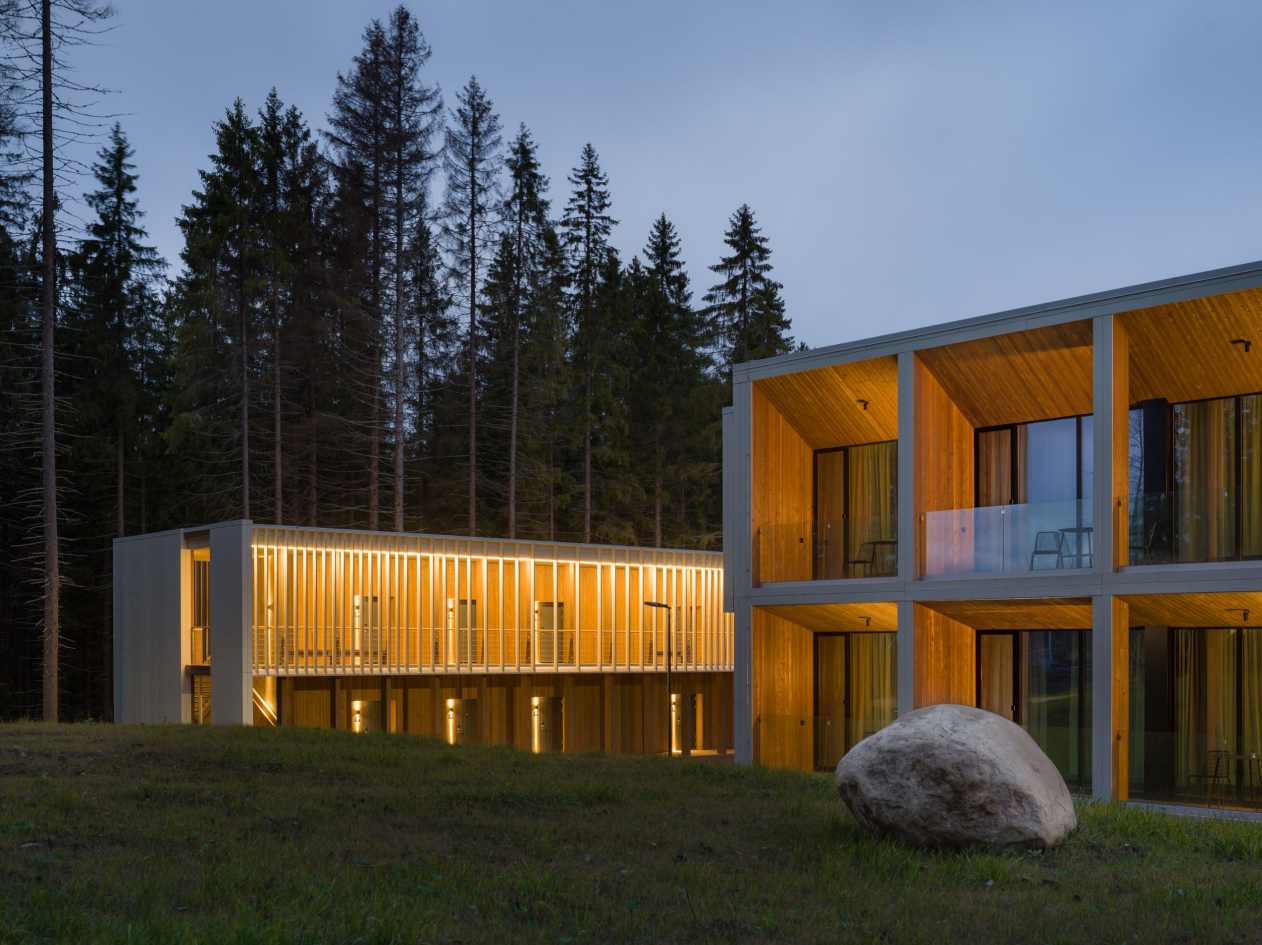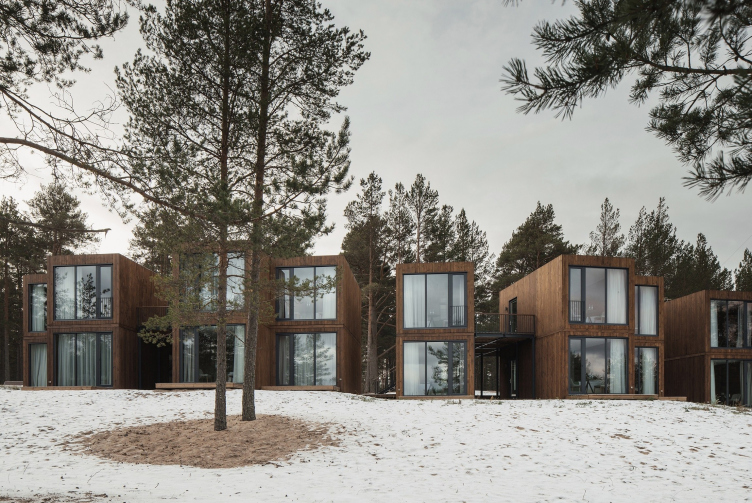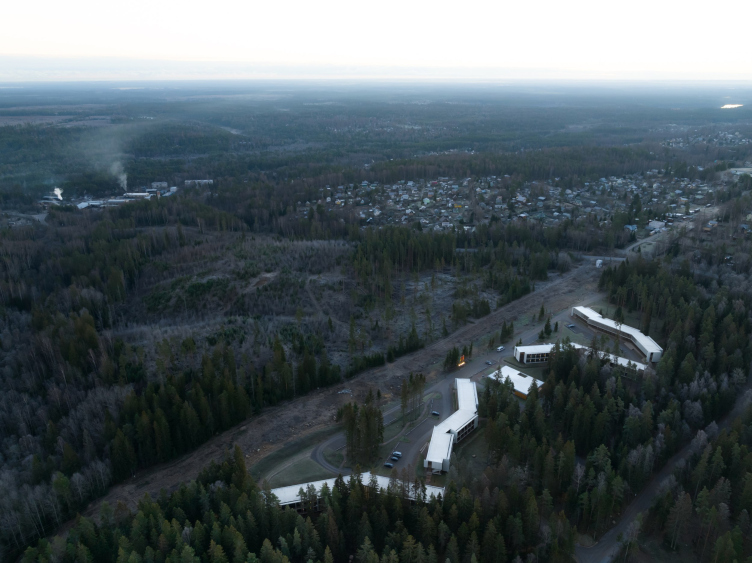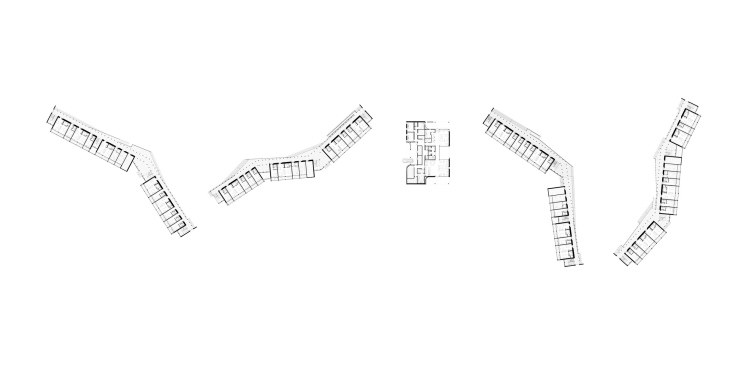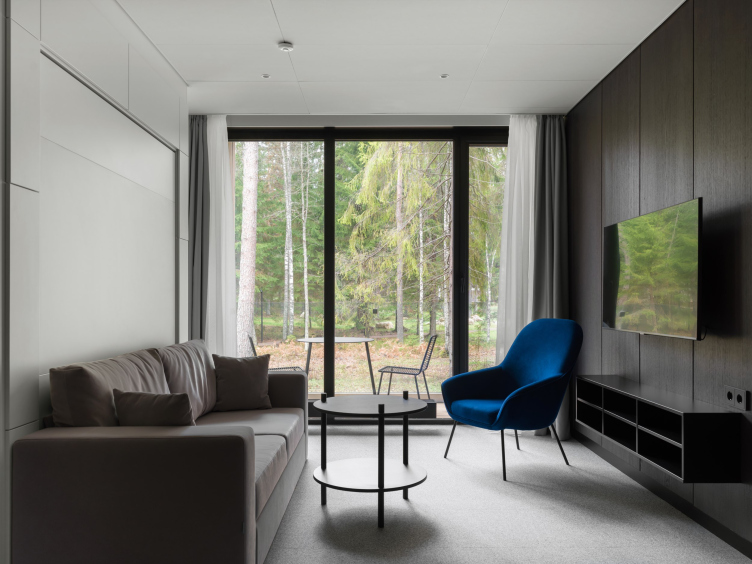"Tochka na Karte« (»Point on the Map") hotel in Priozersk
Copyright: © Rhizome
"Igora. Vremena Goda" hotel
Copyright: Photograph © Dmitry Chebanenko / provided by Rhizome
In all the above-mentioned projects, Rhizome honed and consistently developed the modular approach: all the hotel complexes are composed of standardized “cells” that can be assembled to form a bungalow, small blocks – or large and sophisticated sculptural volumes. Comparing “Vremena Goda” and “Tochka” in Lodeinoe Pole allows you to appreciate the flexibility and efficiency of the approach: the module works equally well the riverside and amidst the trees, responding both to the brief and the site specifics. In Lodeinoe Pole, the basic unit is slightly larger; the decoration of wooden slats and the structural solution of staircase units are somewhat more complex.
In the case of “Igora”, the architects had a few “givens” to work with: a height restriction, a task to accommodate 200 people, and, last but not least, they were to make sure that all the rooms commanded beautiful views. Rhizome grouped the modules into four units, each of which bends in such a way as to make sure that the modules’ panoramic windows command beautiful forest views. The back side of the buildings faces the parking lots. In the center, there is a rectangular building with a reception and a lobby bar.
"Igora. Vremena Goda" hotel
Copyright: Photograph © Sergey Martynov / provided by Rhizome
Each unit is composed of three blocks standing at an angle in respect to each other and consisting of 20 and 40-square meter modules. The family rooms, complemented by a living room and mini-kitchen, have two windows in them: the facade grid thus remains regular, from the outside the larger room can only be identified by the loggia post replacing the blank partition.
"Igora. Vremena Goda" hotel
Copyright: © Rhizome
The blocks are connected by a bypass gallery with glulam construction. On the second floor level, the gallery is decorated with a “curtain” made of thin wooden slats. It is this “back” side of the building that is responsible for the guest’s first impression: it is where they drive up to the hotel and where the entrances to the rooms are located. The rhythm of structural beams and decorative laths, emphasized by the lighting, is constantly changing as the viewer moves and due to the curves of the buildings. The main verticals are complemented by the lines of cladding planking, dark spots of rusticated doors, and staircase steps.
In the places where there are gaps between the blocks, the architects placed staircase nodes, and the connecting fabric is once again openwork laths that provide beautiful-looking shadows. The white color of the staircases gives these spaces a parade-like appearance that brings to mind Soviet rest homes on maybe the “House of Creativity” in Moscow’s Peredelkino.
Using modern and sustainable solutions, we sought to enter into a dialog with the best Nordic examples of mid-20th century hospitality and health architecture, be it Finnish functionalism or Soviet modernism. Hence the choice of applied color and formal solutions.
The lobby designed in the spirit of Mies van der Rohe deserves a special mention. The laconic form is combined here with a very tactile structure of the finish – gabions, which from a distance can be mistaken for shingles, so much so that it blends in with the bark of the surrounding spruce trees. The administrative block, located a little to the side, “strives” to keep a low profile, and metal structures help to “read” its function and separate it from the guest facilities.
It was vital for Igora – one of the most prestigious ski resorts of Leningrad region – to keep up its customer attractiveness during the construction. The modules were able to handle this task as well: much of the work is carried out at the factory, and assembly on site is characterized by neatness – no noise, no dust. The use of highly factory-ready components in the construction made it possible to produce and assemble the hotel in nine months.
"Igora. Vremena Goda" hotel
Copyright: Photograph © Dmitry Chebanenko / provided by Rhizome
After cooperation with Igora, I would like to predict a rapid scaling of Rhizome development: domestic tourism is on the rise, new and old resorts lack spare rooms – so let them be like this: wooden and in tune with nature.
Last week, the project was recognized in the architectural community, taking three awards at once: the jury of ArchiWOOD, Architecton, and G8 Creative Awards recognized it as the best public or tourist building.

